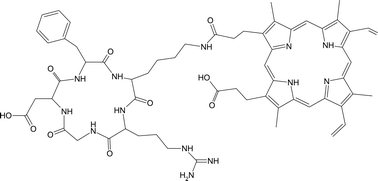Increasing treatment specificity is one of the major aims of cancer research. Photodynamic therapy is a clinically proven treatment for some cancers and certain other diseases. Photosensitisers generally have little intrinsic selectivity for tumours and any accumulation is dependent upon the type of tumour involved. Increasing tumour selective accumulation could improve the efficacy of PDT and reduce any risk of side effects caused by photosensitiser accumulation in non-target tissue. In order to target photosensitisers to tumours, a cyclic peptide, cRGDfK (arginine-glycine-aspartic acid-phenylalanine-lysine) has been synthesised using solid phase peptide chemistry and conjugated to the porphyrin photosensitiser, protoporphyrin IX. The arginine-glycine-aspartic acid (RGD) motif has been shown to specifically bind αvβ3 integrins, heterodimeric glycoproteins upregulated on the surface of proliferating endothelial cells such as those in tumour neovasculature. This study reports the synthesis, in vitro and in vivo characterisation of this novel compound and compares its properties to the free photosensitiser. The individual components in our system, protoporphyrin IX and cRGDfK retain their respective photodynamic and integrin binding activity following the coupling step and produce a conjugate of high purity. The PpIX:cRGDfK conjugate is shown to be a good photosensitiser in vitro in the integrin positive human SiHa cell line and in vivo in a mouse CaNT tumour model. Moreover, pharmacokinetic analysis of PpIX:cRGDfK treated mice shows significant retention and accumulation of photosensitiser in tumour tissue with higher tumour : normal tissue ratios than the free photosensitiser. However, although the conjugate shows this higher accumulation and improved tumour : non-target tissue ratios, the overall in vivo PDT effect, between dose-light intervals of 0 and 6 h, is not significantly better than for free protoporphyrin IX This is possibly due to differences in the target environment or in the subcellular localisation of the compounds.

You have access to this article
 Please wait while we load your content...
Something went wrong. Try again?
Please wait while we load your content...
Something went wrong. Try again?


 Please wait while we load your content...
Please wait while we load your content...